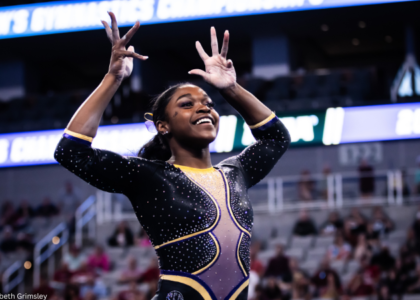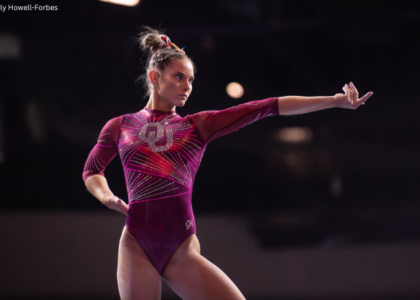Each collegiate team, if branded well enough, will have distinctive design elements that set apart their competition attire from their rivals—think Stanford’s patented Cardinal red, or Ohio State’s buckeye leaf graphic. Colors often set teams apart within the same conference, but in the absence of rhinestones on men’s uniforms, another trend has emerged out of Champaign, Illinois: player numbers. Dating back roughly a decade, each gymnast has had a unique number on the back of his uniform for the duration of his Illini career, not unlike hockey or football.
The quest to put numbers on gymnasts’ backs began in 2012 at the Winter Cup, where then assistant coach Daniel Ribeiro was unsure why numbers were still being assigned per meet and had to be pinned to the athletes. That frustration drove him to study in depth how numbers were used to procure fan engagement in other sports, and possible ways to bridge fan behaviors into men’s gymnastics.
“You look at America and it’s football, baseball, basketball. There’s a lot of things that they do that already work,” Ribeiro said. “These little things I try to figure out—what do these other sports have that make it a little bit more enjoyable, easier to follow, and a little bit easier to understand?”
With no ball to follow in men’s artistic gymnastics, athlete numbers became the frontrunner for a new focal point. Ribeiro adds, “It’s really hard to see the little name on the backs of their jerseys while they’re running and moving. In gymnastics, you can imagine it’s a thousand times harder. They’re flipping and twisting.”
Turn Gymnastics is known in the men’s gymnastics world both internationally and on the collegiate scene for making extremely customized singlets, and sublimating team graphics to remain within budget. When Ribeiro works with Turn on new uniforms, he affirms it’s incredible to work with and makes unique designs. Since the Fighting Illini largely already wore last names on their backs, each uniform already needed to be custom designed and fit for each athlete. Adding a number doesn’t provide any extra hurdles to the manufacturing process or budget, making it a simple adjustment to an otherwise largely unchanged aesthetic norm.
From the outside, the numbers are a gateway into fan engagement. Within the team, it’s a source of bonding and motivation. “The goal going in for me was always that for maybe 19 of my 20 guys, it’s just something fun and it doesn’t really do anything super impactful. But if it could just motivate or inspire one athlete then it’s great,” Ribeiro said. If the numbers continue to serve that purpose, he’ll continue to see it as a positive impact on the sport.
A mere four hours drive east to Columbus, in-conference rival Buckeyes have adopted player numbers for the 2023 season. They are the second NCAA team to do so, with assistant coach Jamie Henderson eager to see how the added identifiers play into his athletes’ earning potential during the new era of college sports.
“The more exposure the better, and with all the NIL opportunities, this is something that needs to happen,” Henderson said. “We have that product that [will] get out there better.” In his time competing under Mark Williams’ fabled Oklahoma Sooners, he and his teammates “always talked about having numbers, but [it was] less of a less of a need and more of a process to get the numbers put on. With printing and embroidering, you can put anything on anything.” Although almost two decades removed from competing in the NCAA, he can now say his team gets to wear numbers.
Further east at Temple University, numbers have also made an appearance in the GymACT under head coach Jesse Kitzen-Abelson. He sees this shift playing into the individualism that GymACT is able to provide, and looks forward to having uniform numbers be standardized league-wide in the future. While budgeting restraints limit how quickly all of their member teams can wear numbers, he takes pride in learning how each of his athletes choose their own. Freshman Nate Davies opted for 12, representing himself and his 11 siblings. “It’s a very personal number for him that he has when he competes,” added Kitzen-Abelson.
Through working with Turn Gymnastics the door opened from numbers to further marketing plans for Temple, such as replica tanks. While the Owls don’t have them currently available, he knows that parents and supporters of the team will be eager to wear them since they reach the gymnastics community in a unique way. Hammering it home, he doubles down and assures that if there were a Kitzen-Abelson replica jersey, his mom would be wearing it. When the Owls hosted the Fred Turoff Invitational this past February at Lincoln Financial Field, it was a dream come true after being born and raised in Philadelphia. His only possible cherry on top would have been jerseys for fans to wear.
As athlete numbers become more prevalent across the landscape of men’s collegiate gymnastics, one question has risen within every team: when and how do numbers retire? Between programs the answers will change, in line with historical team strength and major goals. To Ribeiro and the Fighting Illini, Tyson Bull’s name is at the forefront of the conversation after graduating in 2018. He competed in the 2020 Olympic high bar final and has a host of Big Ten accolades. Compared to other gymnasts in Bull’s era at Illinois, Ribeiro can use him as a benchmark of what it may take to retire a number—his being 13. He also touches on the link between collegiate and elite experience, noting that he thinks the case for retiring a number “mostly needs to come from collegiate, but most of the time those two things go hand in hand…you have to be one of the best in college in order to qualify at the elite level.” He brings it back to Bull, who didn’t have the initial hurdle of making a name for himself in the American elite system but more than made up for that by clearing the world’s depth to compete in multiple major event finals.
Across every team, coaches who have guided their teams into wearing numbers are eager to see how the addition changes the gymnastics experience for both athletes and fans. With numbers likely phasing in as the GymACT standard, Kitzen-Abelson almost expects to see them when he watches the sport. If a team isn’t wearing them, he’ll ask himself, “Where’s their number?” proving the effect that this small customization has had on the sport has grown to be a meaningful one. How does Ribeiro wrap up the influence numbers have had? Quite simply, actually: “No idea is too small if your goal is to improve the impact and fun in your sport.”
READ THIS NEXT: Jamie Henderson Converts Artistry From the Studio to the Gym
Article by Peri Goodman
Like what you see? Consider donating to support our efforts throughout the year!




